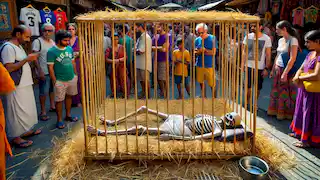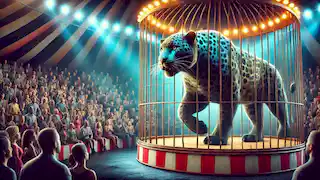In the last decades, the interest in hunger artists has diminished considerably. While at one time, public spectacles of starvation could draw crowds, the fascination with such displays has dwindled. The modern world, teeming with faster forms of entertainment and consumption, no longer holds a place for the somber act of slow starvation. Yet, in those years when hunger art still held a unique allure, one artist stood above the rest.
For many years, this hunger artist had become a master of his craft, not out of vanity but out of pure devotion to the art of fasting itself. The sight of his emaciated form, a body caged behind bars while people streamed by to witness his self-denial, was a testament to a rare kind of suffering—a suffering that the artist saw as the highest form of spiritual attainment. The hunger artist had developed his method to perfection. He would sit in a small cage, placed on display in a central square or marketplace, where onlookers would come to witness his fast. In some cities, these public displays would last for forty days—no more, for beyond that point, the organizers of the event feared for the artist’s life and the crowd’s patience. During this period, the hunger artist would take no food, subsisting only on water. He prided himself on his endurance and discipline, an unwavering devotion to the fast, which to him was a demonstration of his mastery over the body’s basic needs. At first, crowds flocked to see him, and they marveled at his self-control. The artist, clad in a simple robe, would lie on a thin bed of straw, peering out through the bars of his cage at the bustling world outside. On occasion, doctors would come to check on him, weighing his frail body, testing his health, ensuring he wasn’t secretly consuming any food. But the hunger artist remained faithful to his craft, never allowing a morsel to pass his lips. His audience, however, often doubted him. They would whisper among themselves, accusing him of deception, thinking there must be some trick to his survival. The hunger artist heard these accusations, and though they pained him, he never responded. He knew his truth, even if the crowd didn’t. His fasts were not for their amusement or for fame, but for something deeper. To him, the act of starvation was an art form, a means to transcend the limitations of the flesh. Still, despite his dedication, the skepticism of the public gnawed at him more than the hunger itself. As the years passed, the hunger artist found that fewer and fewer people cared for his displays. The world had moved on, and other forms of entertainment took center stage. The advent of cinema, with its fast-moving images and vibrant stories, captured the imagination of the masses far more than the slow agony of a man wasting away in a cage. Crowds that once gathered in awe of the hunger artist's endurance now found his act boring, even morbid. The artist was forced to travel from city to city, seeking out whatever attention he could still garner. But with each passing year, the enthusiasm dwindled, and he was relegated to the fringes of society, performing in small, out-of-the-way towns for paltry audiences. His once-prized ability to fast for forty days was no longer seen as a remarkable feat, but as a relic of a bygone era. The hunger artist grew despondent. He had always fasted out of a genuine belief in the purity of his art, but now he questioned the value of his sacrifices. The public, it seemed, had turned its back on him. And without an audience, could his art still have meaning? The hunger artist longed for recognition—not fame or fortune, but for someone, anyone, to understand the depth of his commitment. He wanted people to see his fast as more than a mere spectacle, but as a profound expression of the human condition. Yet as his audiences grew smaller, so too did his hope for that understanding. In a final attempt to regain some semblance of his former glory, the hunger artist accepted an offer from a circus. It was not the kind of arrangement he would have sought in his earlier years, but with no other options, he agreed to be a part of the circus’s sideshow. He was given a cage near the entrance, where passersby would see him as they entered the big top. But most people paid him little attention, hurrying past him on their way to see the more exciting acts. To the hunger artist, this was the ultimate indignity. He had once been the centerpiece of grand public displays, admired for his endurance and discipline. Now, he was just another curiosity among many, a sideshow attraction to be glanced at briefly and then forgotten. His art, which had once held so much meaning for him, now seemed to be reduced to nothing more than a pathetic spectacle. The hunger artist continued his fasts, but now without the usual forty-day limit. The circus management didn’t care how long he fasted, and so he fasted endlessly, day after day, as the crowds passed by without a second glance. He no longer felt the need to explain himself, no longer felt the need to justify his fast to anyone. His body, already emaciated from years of starvation, became more skeletal with each passing day. But in his mind, the hunger artist still clung to the belief that his fasting had a higher purpose. Even if no one else understood, he believed that his self-denial was a form of spiritual discipline, a way of transcending the limitations of the body and reaching a higher state of being. But the longer he fasted, the more he began to doubt even this. One day, the hunger artist, lying weakly in his cage, was approached by the circus’s overseer. The overseer asked him why he continued to fast, especially now that no one seemed to care. The hunger artist, speaking with great difficulty, explained that he had never been able to find food that he liked. This was the crux of his fast—he had never eaten, not out of willpower, but because no food had ever appealed to him. The overseer, puzzled by the hunger artist’s response, decided to remove him from the cage and replace him with a young, vibrant panther. The panther, in stark contrast to the hunger artist, was full of life and energy, its powerful body pacing restlessly within the cage. Crowds flocked to see the animal, drawn to its raw vitality and strength. The hunger artist, now forgotten, slipped away quietly, his body frail and wasted. No one noticed when the hunger artist died, his life snuffed out as silently as his art had faded from public view. His body was removed from the cage without fanfare, and the circus continued on, the panther now the main attraction. The world had moved on from the hunger artist’s quiet, somber art to something more immediate and exciting. As the hunger artist lay dying, he felt a strange sense of peace. He had lived his life according to his own principles, even if no one else had understood them. He had given himself completely to his art, sacrificing everything for the sake of his fasting. And though the world had forgotten him, he knew that his sacrifice had not been in vain. In his final moments, the hunger artist realized that he had never truly fasted for anyone else’s approval. His fasts had always been for himself, a means of testing the limits of his own body and spirit. And though no one else had understood his art, he knew that he had achieved something extraordinary—he had transcended the physical world, if only for a brief moment, and touched something beyond. His body, weak and frail, could no longer support him, and with a final breath, the hunger artist passed away. His art, like his life, was now complete. In the days following the hunger artist’s death, the panther in the cage became a popular attraction. The crowds marveled at its strength and energy, its powerful muscles rippling beneath its sleek fur. The panther, unlike the hunger artist, had no need to prove anything to anyone. It ate its food with gusto, devoured its meals with satisfaction, and paced its cage with a restless energy that captivated the audience. The panther was everything the hunger artist was not—full of life, strength, and vitality. And yet, in some ways, the panther represented the same desire that had driven the hunger artist to starve himself: the desire to break free from the constraints of the body and live in a state of pure instinct and freedom. The hunger artist had sought this freedom through self-denial, while the panther embodied it naturally, without the need for sacrifice or suffering. The crowd, watching the panther, found in it the excitement and energy that they had once sought in the hunger artist. The panther, with its raw, untamed power, was a symbol of life itself, a life that the hunger artist had willingly turned away from in his pursuit of something higher. The story of the hunger artist is a tale of alienation, sacrifice, and the search for meaning in a world that often fails to understand or appreciate true art . The hunger artist, in his quest to transcend the physical world through fasting, became a symbol of the artist’s struggle to find purpose and recognition in a society that values spectacle over substance. His life, though marked by suffering and isolation, was ultimately a testament to the power of dedication and the pursuit of higher ideals, even in the face of indifference and misunderstanding. Though the hunger artist died without ever achieving the recognition he sought, his story lives on as a reminder of the sacrifices that true artists often make in the name of their art. His fasting, though misunderstood by the world, was a form of expression that transcended the limits of the body and touched on something deeper, something eternal.The Art of Starvation

The Changing Times
A New Arrangement

The Artist's Decline
The Hunger Artist's Final Thought

The Panther

Conclusion

















